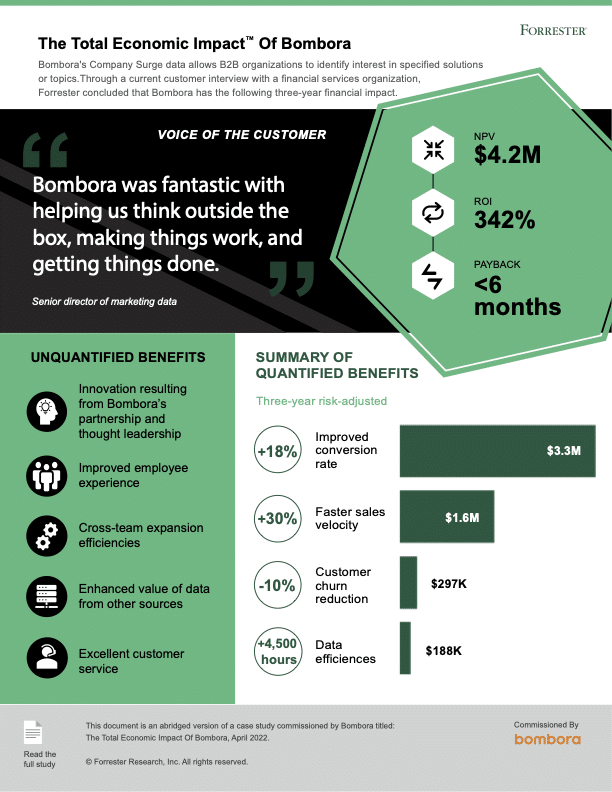Is Bombora’s Intent data really all it’s cracked up to be?
Read Forrester’s Total Economic Impact™ report to find out.
In B2B, there’s no shortage of marketing and sales activities we could be doing.
We could easily fill our days (and our SDRs’ calendars) with list after list of prospects to contact, and we could keep pouring money into top-of-funnel social and display ads, but is all of this activity sustainable?
And does it really result in more revenue and sales success?
This is where the allure of Intent data comes in.
Intent data is information collected about web users’ observed behavior — specifically web content consumption — that provides insights into their interests and indicates Intent to take a specific action. For businesses, that means knowing who’s scoping out your competition or which businesses are inching closer to a buying decision.
The thought of knowing which prospects are actively in the buying cycle for our solutions is undoubtedly attractive, but does the implementation live up to the hype?
We commissioned Forrester Consulting to help cut the fluff and see if Intent data lives up to its promises. (Hint: Heck yeah, it does.)
Total economic impact of using Bombora
To see if Bombora’s *bang* is worth the buck, Forrester conducted a Total Economic Impact™ (TEI) study to examine the potential return on investment (ROI) enterprises may realize by integrating Bombora into their marketing and sales processes.
The study focused on a global B2B financial services organization, but the results align with what we see across the market.
Before using Bombora, this large organization managed lead data manually and didn’t have a comprehensive lead database. They didn’t use behavioral data, and they struggled to prioritize their leads — a pretty familiar tale in the B2B space.
So what did life look like after they integrated Bombora’s Intent data?
The results
Using Bombora, the organization saw a 15% growth in revenue ($3.3m!) through increased conversion rate and sales velocity, reduced customer churn, and efficiency through data management automation.
Here are the details:
18% bump in conversion rate
Intent data lived up to its promise.
By understanding which accounts were actively in-market, the organization was able to prioritize those leads to the top of their outbound sales pipeline. They could also tune their marketing to the specific Intent topics that would align with the potential buyers’ interests.
The combination of these two efforts meant the organization could pursue leads with the highest likelihood of closing and spend less time chasing accounts with the lowest.
Over three years, this conversion rate increase delivered $3.3m in profit.
30% increase in sales velocity
By integrating Bombora into their sales platform, and implementing automated lead-scoring and intelligent event triggering, the interviewee’s organization closed more deals in the same amount of time, generating additional revenue without increasing headcount or time spent.
Over three years, this increase in sales velocity delivered $1.6m profit.
10% decrease in customer churn
Customer retention is no joke!
Bain and Company found that a 5% increase in customer retention increases company profits from 25% to 95%, and Harvard Business Review reported that it’s anywhere from 5 to 25 times cheaper to retain an existing customer than it is to acquire a new one.
Using Bombora’s Intent data to monitor if their customers were actively researching a competitor, the interviewee’s organization could anticipate and prevent customer churn.
Knowing which customers were considering alternatives allowed the organization to proactively reach out and prevent them from jumping ship.
Over three years, customer churn was reduced to less than $300,000.
4,500 hours saved per year
Bombora’s API seamlessly integrated into the organization’s database and sales and marketing workflows, automatically processing the data and pushing prioritized leads to sales team members.
With all these rich insights in hand and no additional systems to manage, Bombora’s automation saved each marketing data team analyst approximately five hours per week.
Over three years, the time savings were worth more than $180,000.
Other benefits of Bombora
In addition to the quantifiable benefits above, Forrester also noted the following:
- Increased innovation from Bombora’s partnership and thought leadership
- Improved employee experience thanks to Bombora’s seamless integration
- Amplified value of existing data (e.g., combining their first-party data with Bombora’s third-party Data Co-op to get a more holistic view of the customer journey)
- Efficiencies in cross-team expansion as more and more teams wanted to take advantage of Intent data
- Great customer service
In summary, the study and financial analysis found that Bombora Intent data provided a net present value (NPV) of $4.2m and an ROI of 342% for the interviewee’s organization.
What else could you do today for 342% ROI?
Are you ready to see if Intent data can help you increase your sales efficiency and reduce your customer churn?
Awesome!
Use this interactive guide to help you understand if your company has the right setup to benefit from Bombora Intent data.
Or request a demo and see why Forrester calls Bombora “the de facto standard in B2B marketing for third-party behavioral data to indicate Intent.”*
It’s time to join the sustainable marketing movement!
* Casey, S. (2020). The Forrester Wave™: B2B Marketing Data Providers, Q3 2018 (Updated). Forester. Retrieved May 10, 2022, from https://www.data-axle.com/wp-content/uploads/2018/01/Forrester-Wave-B2B-Marketing-Data-Providers.pdf


